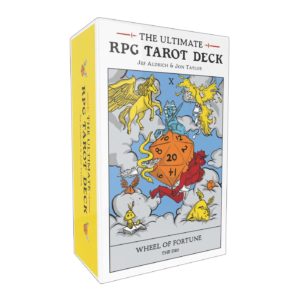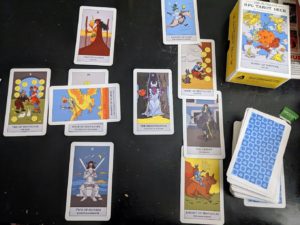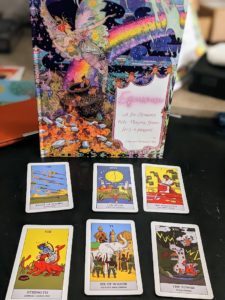Well, hello there, intersection of two of my favorite gaming interests! I mean, how much do I love the intersection of roleplaying games and Tarot? I wrote an entire book incorporating Tarot cards and interpretation into an original RPG!
 So I was really pleased when this came across my reviewing desk. Not only did I want to take a look at this deck as a divination tool, I wanted to see how it would inspire a session of my own game Equinox, substituting the prompts in the included 140+ page guidebook for the ones I’d originally created. The first step, ofc, was to take a look-see at the cards themselves. I brought them to my regular D&D group’s very last Odyssey Of The Dragonlords session — it’s the first D&D campaign I’ve ever finished in its entirety! — and we all oohed and aahed over the product. The box itself is fairly simple, and the cards are a little longer than the average Tarot card, which makes them feel a little weird on first shuffle. The cards are also a bit hard, but regular use will soon soften them up.
So I was really pleased when this came across my reviewing desk. Not only did I want to take a look at this deck as a divination tool, I wanted to see how it would inspire a session of my own game Equinox, substituting the prompts in the included 140+ page guidebook for the ones I’d originally created. The first step, ofc, was to take a look-see at the cards themselves. I brought them to my regular D&D group’s very last Odyssey Of The Dragonlords session — it’s the first D&D campaign I’ve ever finished in its entirety! — and we all oohed and aahed over the product. The box itself is fairly simple, and the cards are a little longer than the average Tarot card, which makes them feel a little weird on first shuffle. The cards are also a bit hard, but regular use will soon soften them up.
The art on the cards is done by Zachary Bacus, with colors by Angueria “Hank” Jones. The Rider-Waite influence is strong, but for the most part the artistic team does a great job of adding (arguably more) fantasy details into each image, encouraging adventure hooks and storytelling. The guide book expands on this further, adding very Dungeons & Dragons-influenced details to each card description. I did appreciate that while D&D was clearly the touchstone for this project, the deck is freely adaptable to any fantasy setting. Some of the choices are a little odder than others — honestly, who uses a Warlord outside of the much-maligned 4E? I had a Tiefling Warlord who was impossible to play (I soon switched over with relief to a Dwarf Avenger) so seeing the class referenced twice here is a bit jarring — but overall you get the archetypes the authors are going for, even if some of them do skew a little more masculine than anticipated. Like, I get why the archetype associated with The Emperor is the Game Master, but having the image on the card look an awful lot like Gary Gygax reinforces the idea that only dudes GM, which is definitely not the case, IME as both player and (female) GM. Sure it’s a nod to the game’s history, and in the larger scheme of things this is a very minor quibble. It’s just hard enough to get people who aren’t cishet white guys into the game, much less running games themselves, without reinforcing a power structure that puts said white guys on the pinnacle.
That aside, the guidebook is very informative, with lots of idea on how to interpret draws for either your standard divination uses or for a more specialized roleplaying function. I had never realized that the 22 Major Arcana can be used as a very cool d20+ substitute, but am already thinking of ways to incorporate this deck into my next D&D game (which will most likely be The Wild Beyond The Witchlight, run by a pregnant female friend of mine, since OotD, which also had a different female GM, just wrapped.)
 Ofc, the real test of a deck is in the spreading. Unless a deck comes with a divination spread that intrigues me, I like to use a Celtic Cross to get a feel for its voice, usually in giving general advice. As you can see, this deck has a surprisingly roundabout way of encouraging me to keep pursuing my artistic hobbies for my own satisfaction. While it reminds me that I should definitely evaluate whether I really need to buy another set of oil pastels before even opening some of the ones I already own, the important thing is that I keep finding the time for myself to make the art I want, to my own tastes and timeline. It’s sage advice delivered in a roundabout way that reminded me of the Dungeon Master from the classic D&D children’s cartoon: cryptic at first, but definitely useful overall.
Ofc, the real test of a deck is in the spreading. Unless a deck comes with a divination spread that intrigues me, I like to use a Celtic Cross to get a feel for its voice, usually in giving general advice. As you can see, this deck has a surprisingly roundabout way of encouraging me to keep pursuing my artistic hobbies for my own satisfaction. While it reminds me that I should definitely evaluate whether I really need to buy another set of oil pastels before even opening some of the ones I already own, the important thing is that I keep finding the time for myself to make the art I want, to my own tastes and timeline. It’s sage advice delivered in a roundabout way that reminded me of the Dungeon Master from the classic D&D children’s cartoon: cryptic at first, but definitely useful overall.
But then comes the true test for any deck claiming to be the Ultimate RPG anything: how well it stands up to actually playing an RPG. I grabbed a copy of Equinox and quickly made up a Changeling character, as it’s come to my attention that there are certain types of characters I avoid playing, and thus playtesting for the RPGs I design. A Changeling in my system is a fae left in the human world, often child-like in appearance, and with a greater affinity for or at least familiarity with humans than most fae have. For her Talisman card, I drew, appropriately enough, the Six Of Cups, which according to the deck signifies Goblin Guidance. I decided that this means that Salma has an affinity for all children, human or fae, and will go out of her way to befriend and protect them. I also decided that the Seelie Court was about to turn Unseelie, and that Salma wasn’t thrilled about this because it meant time away from her human friends.
Next it was time to create a Scene. The first card I drew was the Eight Of Wands, or Rapid Shot. I interpreted this to mean that she’d been entrusted with a message for her King. She didn’t know what was in the message, but she had to hurry to deliver it, through territory that was conflict-torn but that would probably let her pass because of her appearance as a human child.
 The next card I drew was The Moon, or Grand Illusion. This is an easy storytelling interpretation: Salma was halted in her tracks by the appearance of a slavering hellhound on the road in front of her. I decided to roll to see if she could see through the illusion. While my roll succeeded, her attribute for seeing through it was so low that I decided that it takes her several attempts of attempting to placate the beast before she realizes that it isn’t real.
The next card I drew was The Moon, or Grand Illusion. This is an easy storytelling interpretation: Salma was halted in her tracks by the appearance of a slavering hellhound on the road in front of her. I decided to roll to see if she could see through the illusion. While my roll succeeded, her attribute for seeing through it was so low that I decided that it takes her several attempts of attempting to placate the beast before she realizes that it isn’t real.
Interestingly, the third card I drew was The Magician. Having “defeated” the illusion, Salma is ready to keep going, but a sorcerer steps out from hiding, praising her intelligence and stating that the sorcerer has a quest for her. Salma, ofc, is already on a quest, so the two engage in social combat. Defeated, Salma agrees to take on the sorcerer’s mission as a hopefully short quest before continuing back to court with her message.
My fourth card was Strength. I interpreted this to mean that a nearby fae village is being tormented by a real hellhound. Many warriors have attempted to subdue it, but none have succeeded so far. The sorcerer — I decided to call her Sorscha at this point — was looking for someone who might have a more creative way of battling the beast.
Since my next card was Six Of Wands, or Victory Procession, I decided to make Salma’s victory something of a fait accompli. Armed with her experience with the illusory hellhound, as well as her natural charm, Salma goes to the hellhound with an open heart and listening ears. Apparently, it was pregnant and being held by one side of the warring parties, but managed to escape to birth its cubs. Since then, it’s been defending its watering hole against all intruders. Salma tells the hound that the villagers simply want to access their oasis, and will not harm the hound or its cubs once everyone has a chance to sort things out. The hound agrees to carry her and its cubs to the village to negotiate. The villagers are at first frightened, then thrilled to discover that Salma has solved the issue, and arrangements are made to honor each side’s interests and hold a celebratory feast.
So this was going well, I thought, but then I pulled my last card of the scene: The Tower. Ohoho. While this is a Wild Magic card, I decided that I’d just go with the traditional interpretation of Disaster. Salma, Sorscha, the villagers and the hellhounds are just winding up the feast to celebrate their treaty negotiations when riders of the side that originally owned the hellhound come storming in, intent on regaining their possession and razing anything that stands in their path. What will our characters do now?!
I was really impressed by the plot hooks this deck threw out over the course of play, making for a fun and meaningful story in only six short cards. I was certainly far more impressed by this than by some of the other decks that are for ostensible use with RPGs. Overall, this is a great product for anyone interested in incorporating Tarot/divination into their role-playing or vice versa, with some neat extra tips in the guidebook for both. Just mind the slightly longer cards!
The Ultimate RPG Tarot Deck by Jef Aldrich & Jon Taylor was published yesterday June 6 2023 by Adams Media and is available from all good booksellers, including

2 comments
So we should or should not call it the Gygax-Waite deck?
Author
Lol, it’s not as bad as all that! D&D also has it’s own official tarot but I’ve only been able to admire it in a “look but don’t touch” way. Perhaps one of these days…